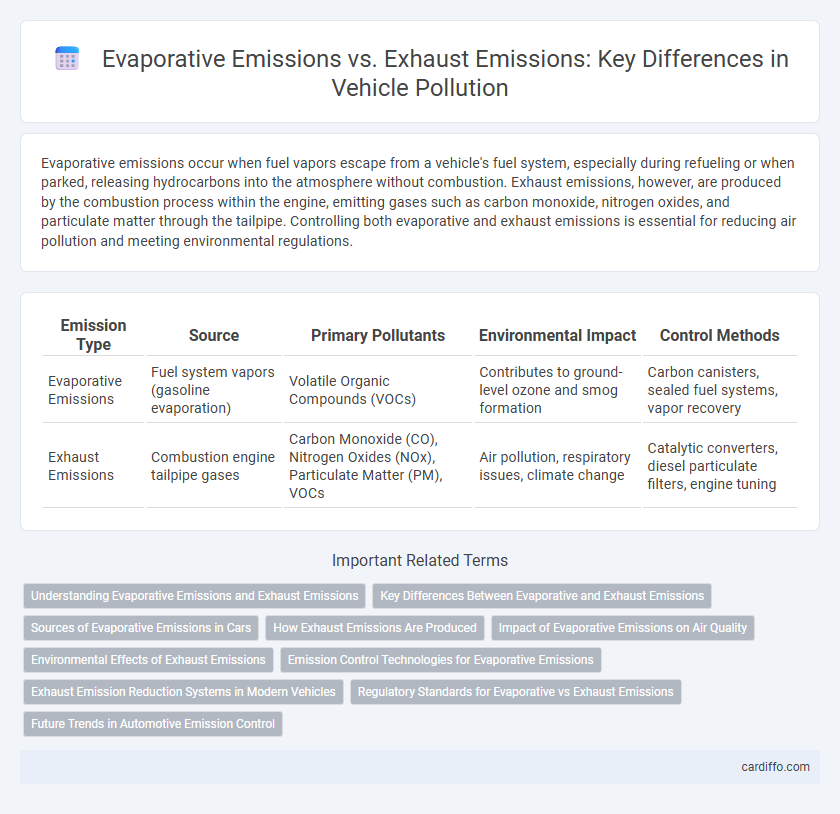Evaporative emissions occur when fuel vapors escape from a vehicle's fuel system, especially during refueling or when parked, releasing hydrocarbons into the atmosphere without combustion. Exhaust emissions, however, are produced by the combustion process within the engine, emitting gases such as carbon monoxide, nitrogen oxides, and particulate matter through the tailpipe. Controlling both evaporative and exhaust emissions is essential for reducing air pollution and meeting environmental regulations.
Table of Comparison
| Emission Type | Source | Primary Pollutants | Environmental Impact | Control Methods |
|---|---|---|---|---|
| Evaporative Emissions | Fuel system vapors (gasoline evaporation) | Volatile Organic Compounds (VOCs) | Contributes to ground-level ozone and smog formation | Carbon canisters, sealed fuel systems, vapor recovery |
| Exhaust Emissions | Combustion engine tailpipe gases | Carbon Monoxide (CO), Nitrogen Oxides (NOx), Particulate Matter (PM), VOCs | Air pollution, respiratory issues, climate change | Catalytic converters, diesel particulate filters, engine tuning |
Understanding Evaporative Emissions and Exhaust Emissions
Evaporative emissions originate from fuel vapors escaping the fuel system, primarily through evaporation, whereas exhaust emissions are produced from the combustion of fuel within the engine. Key pollutants in evaporative emissions include hydrocarbons (HC), while exhaust emissions contain nitrogen oxides (NOx), carbon monoxide (CO), and particulate matter (PM). Understanding the distinct sources and chemical compositions of these emissions is crucial for implementing effective emission control technologies such as carbon canisters for evaporative emissions and catalytic converters for exhaust emissions.
Key Differences Between Evaporative and Exhaust Emissions
Evaporative emissions occur when fuel vapors escape from the fuel system without combustion, primarily from the fuel tank and carburetor, whereas exhaust emissions are the byproducts of fuel combustion released through the vehicle's tailpipe. Evaporative emissions consist mainly of volatile organic compounds (VOCs) that contribute to ground-level ozone formation, while exhaust emissions include carbon monoxide (CO), nitrogen oxides (NOx), hydrocarbons (HC), and particulate matter (PM), impacting air quality and human health. Control technologies for evaporative emissions focus on sealed fuel systems and vapor recovery, while exhaust emission reductions rely on catalytic converters and engine tuning.
Sources of Evaporative Emissions in Cars
Evaporative emissions primarily originate from fuel system components such as the fuel tank, carburetor, and fuel lines where volatile organic compounds (VOCs) escape into the atmosphere. These emissions occur when gasoline evaporates due to temperature changes, pressure variations, or during refueling, contributing significantly to urban air pollution. Control technologies like charcoal canisters and sealed fuel systems are essential to capture and reduce these evaporative hydrocarbon losses.
How Exhaust Emissions Are Produced
Exhaust emissions are produced primarily during the combustion process inside an internal combustion engine when fuel mixes with air and ignites, resulting in the release of gases such as carbon dioxide (CO2), nitrogen oxides (NOx), carbon monoxide (CO), and unburned hydrocarbons. These emissions exit the engine through the exhaust system and contribute significantly to air pollution and greenhouse gas accumulation. The efficiency of fuel combustion and engine design directly affect the volume and composition of exhaust emissions.
Impact of Evaporative Emissions on Air Quality
Evaporative emissions, consisting primarily of volatile organic compounds (VOCs), significantly contribute to ground-level ozone formation, worsening urban smog and respiratory health issues. Unlike exhaust emissions, which are directly released during combustion, evaporative emissions occur through fuel evaporation in storage and vehicle systems, making them a persistent source of air pollution even when engines are off. Controlling evaporative emissions is crucial for improving air quality and reducing the overall burden of photochemical smog in densely populated areas.
Environmental Effects of Exhaust Emissions
Exhaust emissions release harmful pollutants such as nitrogen oxides (NOx), carbon monoxide (CO), particulate matter (PM), and volatile organic compounds (VOCs) directly into the atmosphere, significantly contributing to air pollution and respiratory health issues. These emissions increase greenhouse gases like carbon dioxide (CO2), exacerbating climate change and urban smog formation. Unlike evaporative emissions, exhaust emissions result from combustion processes, producing more concentrated and toxic environmental impacts.
Emission Control Technologies for Evaporative Emissions
Emission control technologies for evaporative emissions primarily include activated carbon canisters designed to capture and store fuel vapors before they escape into the atmosphere. Advanced systems integrate vapor recovery valves and purge valves that regulate the flow of vapors to the engine for combustion, significantly reducing hydrocarbon emissions. Innovations such as onboard diagnostics (OBD) continuously monitor evaporative emission control integrity, ensuring compliance with stringent environmental standards.
Exhaust Emission Reduction Systems in Modern Vehicles
Exhaust emission reduction systems in modern vehicles primarily include catalytic converters, diesel particulate filters, and selective catalytic reduction (SCR) systems, which significantly lower harmful pollutants such as nitrogen oxides (NOx), carbon monoxide (CO), and particulate matter. Advanced engine control units (ECUs) optimize fuel combustion to minimize exhaust emissions, enhancing overall air quality. These technologies are crucial in meeting stringent regulatory standards like Euro 6 and Tier 3, targeting substantial declines in vehicle exhaust pollutants.
Regulatory Standards for Evaporative vs Exhaust Emissions
Regulatory standards for evaporative emissions primarily target the control of fuel vapor leaks and permeation, with agencies like the EPA enforcing limits through programs such as the Evaporative Emission Control System (EVAP). Exhaust emissions regulations, including standards from the EPA and Euro 7, focus on limiting pollutants like NOx, CO, and particulate matter released during combustion, monitored via tailpipe measurements. Compliance with both sets of standards is critical for automotive manufacturers to reduce overall vehicular pollution and meet stringent environmental requirements.
Future Trends in Automotive Emission Control
Future trends in automotive emission control emphasize reducing evaporative emissions through advanced fuel system designs and improved vapor recovery technologies. Innovations such as enhanced canister-based adsorption systems and real-time monitoring sensors are targeting the minimization of hydrocarbon releases during vehicle operation and parking phases. Exhaust emission control continues to evolve with increasingly stringent regulations driving adoption of next-generation catalytic converters and selective catalytic reduction systems to lower NOx and particulate matter emissions.
Evaporative Emissions vs Exhaust Emissions Infographic

 cardiffo.com
cardiffo.com